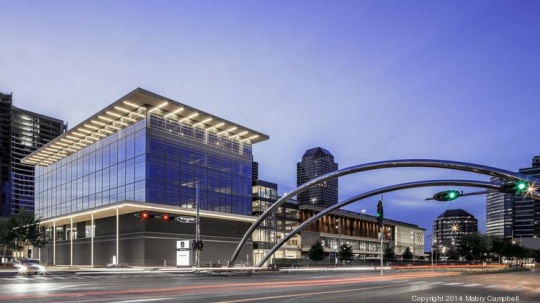American Cross-Dock & Storage leased 102,863 square feet of industrial space at 9701 New Decade Drive, Pasadena.
Transwestern Commercial Services completed 187,054 square feet of office leases at Westchase Park I and II at 3700 and 3600 W. Sam Houston Parkway North. LJA Engineering, represented by Anthony Squillante and Dustin Devine of Stream Realty Partners, leased 90,989 square feet; Centurion Pipeline Co., represented by Lonna Dorman of Transwestern, leased 28,078 square feet; and ABB, represented by Beau Bellow and Josh Hirsch of JLL, renewed its lease for 67,987 square feet. The new tenants will take occupancy in the first half of 2020. Transwestern’s Eric Anderson, Parker Burkett, and Katy Gragg represented the owner, Clarion Partners. The 569,825-square-foot Westchase Park office complex has a freestanding amenity center with a Citrus Kitchen restaurant, fitness center with locker rooms and tenant conference center with seating for up to 100.
American Cross-Dock & Storage, a family-owned and operated logistics company led by president and CEO Deborah Bressie, signed two leases totaling 146,863 in Pasadena. The company leased 102,863 square feet of industrial space at 9701 New Decade Drive in the Bayport North Logistics Center I, from Triten Real Estate Partners, for storage and distribution, and subleased 44,000 square feet at 13225 Bay Park Road for drayage and cross-dock services. Bob Berry and Grant Hortenstine of Avison Young represented the tenant, while Jason Dillee and Andrew Jewett of CBRE represented the landlord. The company has more than doubled its space since being founded in March 2018. It provides warehousing, trans-loading, fulfillment and packaging services to the Greater Houston area.
Houston-based Hartman Income REIT purchased a three-property office portfolio totaling 254,225 square feet from New York-based HighBrook Investors. JLL Capital Markets, led by Martin Hogan, marketed the property on behalf of the seller and procured the buyer. The portfolio consists of 16420 Park Ten and 1400 Broadfield in the Energy Corridor’s Park 10 Business Park, as well as 7915 FM 1960 near Willowbrook Mall in northwest Harris County. The portfolio is 55 percent leased.
Deugro (USA) leased 16,625 square feet at 480 Wildwood Forest Drive, The Woodlands, for the relocation of its headquarters. Weldon Martin with CBRE represented the tenant. Steve Rocher and Jason Presley of CBRE represented the landlord, GeoSouthern Budde RD LLC.
Humble Independent School District purchased a 50-acre site at the intersection of Will Clayton Parkway and Rustic Woods Drive. The property was purchased from Lennar Homes of Texas for a future elementary school. Mark Wimberly of Houston Commercial Development represented the buyer.
A local investor purchased The Place at Greenway, a 219-unit garden-style apartment complex at 3333 Cummins St. Chris Curry, Todd Marix, Joey Rippel, Chris Young and Bailey Crowell of JLL represented the seller, Redwood Capital Group. Michael Johnson and Tolu Akindele of JLL arranged a five-year, fixed-rate acquisition loan from Ready Capital for the new owner. The property, on 6 acres near Richmond Avenue and Weslayan in the Greenway Plaza area, consists of 15 two-story residential buildings built in the early 1960s. The complex is 95 percent leased.
Oldham Goodwin Capital, in partnership with MGroup + Architects, broke ground on the second phase of Catalon at Lago Mar apartments at 6130 Lago Mar Blvd. in Texas City. The addition will bring 170 units ranging from 715 to 1,417 square feet in four buildings. Completion is planned in November 2020.
Brookdale Home Health leased 3,046 square feet of office space at 15425 North Freeway. Trey Martin of NAI Partners represented the tenant.
Blackstone Builder renewed a lease for 1,124 square feet at 2401 Fountain View Drive. John Buckley with Finial Group represented the landlord.
ESA Business purchased 2.2 acres at the southeast corner of Will Clayton Parkway and South Houston Avenue in Humble for a future fueling station and retail center. Mark Wimberly of Houston Commercial Development represented the seller, Doyle Bond Family Partnership.








 When the opportunity zone program was announced in late 2017, Dosch Marshall Real Estate Vice President Tripp Rich received a lot of calls about the program, including from firms he was not familiar with. The initial prospect of the tax exemption was so attractive and unheard of that everyone wanted in. Houston showed particular promise: The MSA has the highest concentration of assets in opportunity zones — 21.7% compared to the national average at 12.6%, according to the commercial real estate data platform Reonomy. “Houston should attract more opportunity zone projects than any other city,” Reonomy Vice President of Marketing Sam Viskovich said. But investment interest in the program has dwindled, and Rich said the number of firms talking to him about participating has dropped. Bisnow Archives/Kyle Hagerty Houston skyline Qualified opportunity funds have raised less than 10 cents on the dollar of the program’s targeted goal in 2019, according to CoStar. In Houston, the percentage of total commercial investment within opportunity zones has dropped from 38.5% in 2017, which is the highest in a nearly 20-year span, to 16.4% for the first quarter of 2019, according to a report by Reonomy. There are at least three possible reasons for the slowdown, Viskovich said. It could be related to the number of sites in high-targeted areas. Since the program used 2010 census data and input from local leaders, some zones were already experiencing an influx of capital. He also noted the maturing cycle could have some investors tightening the purse strings and focusing on the tried-and-true deals. But some of the drops may just be that deals haven’t happened yet, not that they won’t happen at all. The initial obscurity of the program caused some to take a wait-and-see approach. Viskovich expects those who are satisfied with the new guidance (released by the IRS in April) will move forward with their projects. Courtesy of Reonomy Reonomy Vice President of Marketing Sam Viskovich The pace of investment activity for the rest of the year will be a good indicator of the future traction of the opportunity zone program, Viskovich said. Rich expects a big rush to close on sites closer to 2020. Opportunity zone projects follow the traditional development timeline and process — the deals take time. It could take up to 12 months after the site is under contract to break ground. And until dirt turns, developers are keeping quiet about their plans. “No one wants to talk about a project until they know it is about to happen,” he said. The rise in pricing in opportunity zones is one reason to stay optimistic about the program’s future in Houston. Since the announcement of the OZ program, the average sales price for properties in Houston opportunities zones has increased significantly compared to properties, not in opportunity zones, which have remained steady. Multifamily development has been the go-to property type for opportunity zone investment in Houston, said JLL Senior Vice President Jonathan Paine, whose team arranged construction financing and equity for Hines’ The Preston, a 373-unit luxury apartment project funded by Cresset-Diversified QOZ Fund in Downtown Houston. He is engaged with more than 10 opportunity zone projects across the country, made up mostly of multifamily developments. A local developer is planning two apartment complexes in the Inner Loop, Rich said. A national QOZ fund plans to spend upwards of $350M in Texas, Arizona, Colorado, Kansas, New Mexico, Oklahoma, and Utah, according to Rich. The fund is targeting mostly multifamily development, while office and mixed-use projects are also being considered. Courtesy of Dosch Marshall Real Estate Dosch Marshall Real Estate Vice President Tripp Rich Developers are opting for apartments and hotels because they can be built quicker; the quality can be sustained over a long period; there is no pre-leasing required for financing; and, unlike office development, they are not dependent on long-term leases, Paine said. He expects retail development to come in the next phase of investment as zones become more densified. Industrial development is also feasible; he is in talks with a fund to develop an industrial building in an opportunity zone out of state. More than a fourth of the properties in Houston’s opportunity zones are categorized as commercial general and about 25% is multifamily, according to Reonomy. Retail and industrial come in as third and fourth in the share of assets in opportunity zones. Zones in Houston’s Inner Loop, which includes already-revitalizing areas such as downtown, are expected to benefit the most under the opportunity zone program, Rich said. That is partial because all opportunity zone projects must pencil out. While the federal program was designed to stimulate commercial expansion in economically distressed areas by providing a tax benefit in exchange for a long-term investment, being in an opportunity alone doesn’t make a project a safe bet. Bisnow/Catie Dixon Hanover Co.’s Brandt Bowden, JLL’s Jonathan Paine and Weingarten CEO Drew Alexander at Bisnow Houston’s capital markets event February 2016 Investors and developers have become more mindful when selecting partners, as funds must hold properties at least 10 years to maximize the tax benefits of the program, Paine said. These projects will require a long-term commitment from both sides. Developers want to pick the fund early in the development process before designing and permitting the project, which helps to share the cost and provide input on the scope and viability of the project, Paine said. For example, one opportunity zone partnership in Las Vegas is considering how the next owner will perceive the quality of the product, Paine said. They opted for higher-quality materials and exterior cladding that will provide durability and functionality in the long run. While the upgrades ultimately add 10% to 15% more to the budget, the idea is that the property will retain its value. “They were in agreement that was the best thing for a project that they were going to own for 10 years,” he said. While the number of investors eyeing Houston opportunity zone deals has shrunk, that isn’t necessarily concerning. Since the Treasury Department released the second round of guidance in April, sophisticated funds are moving forward with development plans while the delays and intricacies of the process have weeded out less experienced real estate investors. The QOFs interested in building in Houston come from the same group of investors that have considered Houston in prior investment periods, Paine said. The most active groups are ready to deploy capital with the staff and the knowledge to meet and maintain the regulations set by the federal government.
When the opportunity zone program was announced in late 2017, Dosch Marshall Real Estate Vice President Tripp Rich received a lot of calls about the program, including from firms he was not familiar with. The initial prospect of the tax exemption was so attractive and unheard of that everyone wanted in. Houston showed particular promise: The MSA has the highest concentration of assets in opportunity zones — 21.7% compared to the national average at 12.6%, according to the commercial real estate data platform Reonomy. “Houston should attract more opportunity zone projects than any other city,” Reonomy Vice President of Marketing Sam Viskovich said. But investment interest in the program has dwindled, and Rich said the number of firms talking to him about participating has dropped. Bisnow Archives/Kyle Hagerty Houston skyline Qualified opportunity funds have raised less than 10 cents on the dollar of the program’s targeted goal in 2019, according to CoStar. In Houston, the percentage of total commercial investment within opportunity zones has dropped from 38.5% in 2017, which is the highest in a nearly 20-year span, to 16.4% for the first quarter of 2019, according to a report by Reonomy. There are at least three possible reasons for the slowdown, Viskovich said. It could be related to the number of sites in high-targeted areas. Since the program used 2010 census data and input from local leaders, some zones were already experiencing an influx of capital. He also noted the maturing cycle could have some investors tightening the purse strings and focusing on the tried-and-true deals. But some of the drops may just be that deals haven’t happened yet, not that they won’t happen at all. The initial obscurity of the program caused some to take a wait-and-see approach. Viskovich expects those who are satisfied with the new guidance (released by the IRS in April) will move forward with their projects. Courtesy of Reonomy Reonomy Vice President of Marketing Sam Viskovich The pace of investment activity for the rest of the year will be a good indicator of the future traction of the opportunity zone program, Viskovich said. Rich expects a big rush to close on sites closer to 2020. Opportunity zone projects follow the traditional development timeline and process — the deals take time. It could take up to 12 months after the site is under contract to break ground. And until dirt turns, developers are keeping quiet about their plans. “No one wants to talk about a project until they know it is about to happen,” he said. The rise in pricing in opportunity zones is one reason to stay optimistic about the program’s future in Houston. Since the announcement of the OZ program, the average sales price for properties in Houston opportunities zones has increased significantly compared to properties, not in opportunity zones, which have remained steady. Multifamily development has been the go-to property type for opportunity zone investment in Houston, said JLL Senior Vice President Jonathan Paine, whose team arranged construction financing and equity for Hines’ The Preston, a 373-unit luxury apartment project funded by Cresset-Diversified QOZ Fund in Downtown Houston. He is engaged with more than 10 opportunity zone projects across the country, made up mostly of multifamily developments. A local developer is planning two apartment complexes in the Inner Loop, Rich said. A national QOZ fund plans to spend upwards of $350M in Texas, Arizona, Colorado, Kansas, New Mexico, Oklahoma, and Utah, according to Rich. The fund is targeting mostly multifamily development, while office and mixed-use projects are also being considered. Courtesy of Dosch Marshall Real Estate Dosch Marshall Real Estate Vice President Tripp Rich Developers are opting for apartments and hotels because they can be built quicker; the quality can be sustained over a long period; there is no pre-leasing required for financing; and, unlike office development, they are not dependent on long-term leases, Paine said. He expects retail development to come in the next phase of investment as zones become more densified. Industrial development is also feasible; he is in talks with a fund to develop an industrial building in an opportunity zone out of state. More than a fourth of the properties in Houston’s opportunity zones are categorized as commercial general and about 25% is multifamily, according to Reonomy. Retail and industrial come in as third and fourth in the share of assets in opportunity zones. Zones in Houston’s Inner Loop, which includes already-revitalizing areas such as downtown, are expected to benefit the most under the opportunity zone program, Rich said. That is partial because all opportunity zone projects must pencil out. While the federal program was designed to stimulate commercial expansion in economically distressed areas by providing a tax benefit in exchange for a long-term investment, being in an opportunity alone doesn’t make a project a safe bet. Bisnow/Catie Dixon Hanover Co.’s Brandt Bowden, JLL’s Jonathan Paine and Weingarten CEO Drew Alexander at Bisnow Houston’s capital markets event February 2016 Investors and developers have become more mindful when selecting partners, as funds must hold properties at least 10 years to maximize the tax benefits of the program, Paine said. These projects will require a long-term commitment from both sides. Developers want to pick the fund early in the development process before designing and permitting the project, which helps to share the cost and provide input on the scope and viability of the project, Paine said. For example, one opportunity zone partnership in Las Vegas is considering how the next owner will perceive the quality of the product, Paine said. They opted for higher-quality materials and exterior cladding that will provide durability and functionality in the long run. While the upgrades ultimately add 10% to 15% more to the budget, the idea is that the property will retain its value. “They were in agreement that was the best thing for a project that they were going to own for 10 years,” he said. While the number of investors eyeing Houston opportunity zone deals has shrunk, that isn’t necessarily concerning. Since the Treasury Department released the second round of guidance in April, sophisticated funds are moving forward with development plans while the delays and intricacies of the process have weeded out less experienced real estate investors. The QOFs interested in building in Houston come from the same group of investors that have considered Houston in prior investment periods, Paine said. The most active groups are ready to deploy capital with the staff and the knowledge to meet and maintain the regulations set by the federal government.